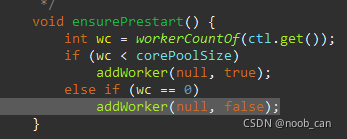两者都可用来延时或定时执行任务,在实现上它两的设计思路是相似的,细节逻辑上略有差异。
相同
一、
都有一个可变数组队列来保存任务。
将它看做一个完全二叉树结构( x, 2x, 2x+1),队列内不保证所有元素严格有序,但树结构上的每一个三元组<left, parent, right> 里 parent一定是最小的;那么任意子树的root一定是全局最小。
当队列元素发生入队、出队时,都会按“下一个执行时间” 进行堆排序来保证队首元素的延时是最少的。
二、
在各自封装任务的类结构里,都有一个 long类型属性“period” , 通过它来确定任务下一次执行时间。
- 0 : 一次性任务,在调用方法时不要指定“period” 。
- 正数: 更新 nextExecutionTime = 上一次的nextExecutionTime + period 。 scheduleAtFixedRate
- 负数: 更新 nextExecutionTime = now() - period 。 scheduleWithFixedDelay
不同
一、
- Timer里使用的是单线程TimerThread阻塞式依次执行,只能捕获并无视InterruptedException ,其他异常会抛出并退出线程,定时器失效。
- ScheduledThreadPoolExecutor将任务封装成了ScheduledFutureTask,FutureTask的执行方法#run()、#runAndReset()内部会捕获并处理异常,所以不影响线程池内工作线程的运行。
二、
当周期性执行任务时:
- Timer是在任务执行开始前就计算下次执行时间;
- ScheduledThreadPoolExecutor因为是线程池的工作模式,所以:任务会先弹出队列,在执行完成后才计算下次执行时间。
三、
Timer可以指定具体的某个执行时间点,而ScheduledThreadPoolExecutor不行。

ScheduledThreadPoolExecutor
public ScheduledThreadPoolExecutor(int corePoolSize, ThreadFactory threadFactory) {
super(corePoolSize, Integer.MAX_VALUE, 0, NANOSECONDS, new DelayedWorkQueue(), threadFactory);
}
// 一次性任务, 就没有指定period
public ScheduledFuture<?> schedule(Runnable command, long delay, TimeUnit unit) {
if (command == null || unit == null)
throw new NullPointerException();
RunnableScheduledFuture<?> t = decorateTask(command, new ScheduledFutureTask<Void>(command, null, triggerTime(delay, unit)));
delayedExecute(t);
return t;
}
// 按固定的频率执行, 这里period是正数
public ScheduledFuture<?> scheduleAtFixedRate(Runnable command, long initialDelay, long period, TimeUnit unit) {
if (command == null || unit == null)
throw new NullPointerException();
if (period <= 0)
throw new IllegalArgumentException();
ScheduledFutureTask<Void> sft =
new ScheduledFutureTask<Void>(command, null, triggerTime(initialDelay, unit), unit.toNanos(period)); // 这里period是正数
RunnableScheduledFuture<Void> t = decorateTask(command, sft);
sft.outerTask = t;
delayedExecute(t);
return t;
}
// 按固定的延时执行, 这里period是负数
public ScheduledFuture<?> scheduleWithFixedDelay(Runnable command, long initialDelay, long period, TimeUnit unit) {
if (command == null || unit == null)
throw new NullPointerException();
if (period <= 0)
throw new IllegalArgumentException();
ScheduledFutureTask<Void> sft =
new ScheduledFutureTask<Void>(command, null, triggerTime(initialDelay, unit), unit.toNanos(-period)); // 这里period是负数
RunnableScheduledFuture<Void> t = decorateTask(command, sft);
sft.outerTask = t;
delayedExecute(t);
return t;
}有两个内部类:
- 将传入的任务Runnable | Callable 封装为 ScheduledFutureTask ,它实现了:
- 接口方法java.util.concurrent.Delayed#getDelay的实现是:获取当前时间和下次执行时间的差值 。
- 接口方法Comparable<Delayed>#compareTo是比较Delayed#getDelay的值,小的在前面。
- 任务存放在延时阻塞队列DelayedWorkQueue里,在有元素变动时堆排序来保证队首元素一定是最近要执行的,判定依据是Comparable<Delayed>#compareTo 。
它本质是一个线程池,从它的构造函数可知:
- 只可以指定核心线程数。
- DelayedWorkQueue是可变数组(grow 50%:newCapacity = oldCapacity + (oldCapacity >> 1)),容量不超过Integer.MAX_VALUE;
所以当corePoolSize > 0 时, 基本上是不会有超corePoolSize量的线程。
当任务新添入阻塞队列后,会执行ThreadPoolExecutor#ensurePrestart()方法来检测:【当前运行中的线程数量 小于核心线程数或为0】时,增加一个工作线程。

新增任务
新插入到队尾 DelayedWorkQueue#siftUp:
循环向上,若比三元组内parent还小就与parent交换位置,同时上升到此交换位置作为child 的上一个三元组内比较。(已有的数据已经满足每个三元组结构里parent一定是最小的)
eg. (n1,n2,n3)、 (n2,n4,n5)、(n3,n6,n7)、 (n4,n8,n9);在每个三元组里parent一定是最小的,即: (n1,n2,n3)里 n1 一定是最小的 ; 同时任意子树root一定是它的全局最小。
任务的执行
DelayedWorkQueue#take() 弹出队首元素
只有当设定了多个核心线程数时,才会有并发。
- 首先是经过队列唯一ReentrantLock锁的限制;
- 当A工作线程判定队首任务还未到执行时间,A线程挂起等待差额时间,锁被释放(Condition#awaitNanos);“leader” 被绑定为A线程。
- B工作线程拿到ReentrantLock权限后, 注意了: 此时判定“leader”是A, B线程会永久挂起(Condition#await())直到被其他线程唤醒! 通过这种方式来防止并发重复问题。当A线程在挂起后其他工作线程也无法弹出任务。
- A超时自动苏醒后依旧是第一个处理者。此时会执行DelayedWorkQueue#finishPoll :将队尾元素置顶后,#siftDown 堆排序向下比较,若大于min(left、right ) 就与min交换位置,同时下降到此交换位置作为parent的下一个三元组内比较。
// 通过插入时siftUp、弹出siftDown 操作来保证队列里任一子树的根节点一定是最小值, 但不保证全局有序
public RunnableScheduledFuture<?> take() throws InterruptedException {
final ReentrantLock lock = this.lock;
lock.lockInterruptibly();
try {
for (;;) {
RunnableScheduledFuture<?> first = queue[0]; // 这里是拿队首元素来判定
if (first == null)
available.await(); // 队首为空则挂起工作线程等待
else {
long delay = first.getDelay(NANOSECONDS);
if (delay <= 0)
return finishPoll(first); // 已到执行时间, 队列删除队首元素并调整剩下队内的元素的位置 -> siftDown
first = null; // don't retain ref while waiting 置空
if (leader != null)
available.await(); // 已经绑定了工作线程,则当前工作线程挂起
else {
Thread thisThread = Thread.currentThread();
leader = thisThread;
// 绑定唯一的工作线程,主要用来保证在下面awaitNanos时, 依旧可以占着当前队列权限, 防止多线程并发下都自动苏醒后处理到同一个任务
try {
available.awaitNanos(delay);
} finally {
if (leader == thisThread)
leader = null;
}
}
}
}
} finally {
if (leader == null && queue[0] != null)
available.signal();
lock.unlock();
}
}
/** 弹出原队首任务后, 将队尾任务移动到队首, 再向下比较替换 */
private void siftDown(int k, RunnableScheduledFuture<?> key) {
int half = size >>> 1;
while (k < half) {
int child = (k << 1) + 1;
RunnableScheduledFuture<?> c = queue[child];
int right = child + 1;
if (right < size && c.compareTo(queue[right]) > 0)
c = queue[child = right];
if (key.compareTo(c) <= 0)
break;
queue[k] = c;
setIndex(c, k);
k = child;
}
queue[k] = key;
setIndex(key, k);
}
/** add插入队尾时 队列元素从底向上比较替换 */
private void siftUp(int k, RunnableScheduledFuture<?> key) {
while (k > 0) {
int parent = (k - 1) >>> 1; // 从底向上比较替换
RunnableScheduledFuture<?> e = queue[parent];
if (key.compareTo(e) >= 0)
break;
queue[k] = e;
setIndex(e, k);
k = parent;
}
queue[k] = key;
setIndex(key, k);
}ScheduledFutureTask#run
通过“period”来判定是否周期性任务。如果是周期性的,在任务执行完成之后会设置新的NextRunTime, 再将该ScheduledFutureTask添加回阻塞队列中。
public void run() {
boolean periodic = isPeriodic(); // period != 0 是周期
if (!canRunInCurrentRunState(periodic))
cancel(false);
else if (!periodic)
ScheduledFutureTask.super.run(); // 非周期性任务执行
else if (ScheduledFutureTask.super.runAndReset()) { // 周期性任务FutureTask执行并重置之后
setNextRunTime(); // 设置下次执行的时间
reExecutePeriodic(outerTask); // 重新入DelayedWorkQueue队列
}
}
}ScheduledFutureTask#setNextRunTime方法设置下一次执行时间 :
- period > 0 : 新“nextExecutionTime” = 原“nextExecutionTime” + “period”。 固定的时间点频率。
- period < 0 : 新“nextExecutionTime” =( now())任务执行完成后的System.currentTimeMillis() - “period”。 任务执行完成后按固定延时。
private void setNextRunTime() {
long p = period;
if (p > 0) time += p; // 上次的执行时间直接加上period
else time = triggerTime(-p); // 当前系统时间加period
}
long triggerTime(long delay) {
return now() + ((delay < (Long.MAX_VALUE >> 1)) ? delay : overflowFree(delay));
}Timer
内部持有一个线程对象TimerThread和一个存储TimerTask的数组队列TaskQueue(扩容翻倍)。
新任务追加到数组的末尾, fixUp 从树底向上比较置换。
在单线程TimerThread#mainLoop()里:
- 从队列TaskQueue里拿第一个任务(The tasks are stored in queue[1] up to queue[size] 这么做是为了在堆排序计算(x,2x,2x+1)时更方便)。这里控制并发是用的synchronized与Object#wait(long timeout)
- 若是周期性任务,在任务执行开始前就会更新下一次的执行时间并队列内再排序#fixDown。当 period < 0 : 新“nextExecutionTime” =( now())任务执行开始前的System.currentTimeMillis() - “period”。
private void mainLoop() {
while (true) {
try {
TimerTask task;
boolean taskFired;
synchronized(queue) { // 控制队列并发
while (queue.isEmpty() && newTasksMayBeScheduled)
queue.wait();
if (queue.isEmpty())
break;
long currentTime, executionTime;
task = queue.getMin(); // 拿队首任务queue[1]
synchronized(task.lock) { // 限制一个任务不能被同时处理(eg. 上次还未执行完, 这次又拿到了该任务)
if (task.state == TimerTask.CANCELLED) {
queue.removeMin();
continue; // No action required, poll queue again
}
currentTime = System.currentTimeMillis();
executionTime = task.nextExecutionTime;
if (taskFired = (executionTime<=currentTime)) {
if (task.period == 0) { // 一次性任务 直接从队列里移除
queue.removeMin();
task.state = TimerTask.EXECUTED;
} else { // 周期性任务, 重新设置执行时间并塞回队列,将重新排序确定它的位置
queue.rescheduleMin(
task.period<0 ? currentTime - task.period : executionTime + task.period); // fixDown(1)
}
}
}
if (!taskFired) // 任务还没到执行时间, 则等待
queue.wait(executionTime - currentTime);
}
if (taskFired) // Task fired; run it, holding no locks
task.run(); // 执行任务
} catch(InterruptedException e) { // 忽略InterruptedException,其他的异常会跳出线程
}
}
}
// 队首元素更新了下一次执行时间后, 从底向下比较置换
private void fixDown(int k) {
int j;
while ((j = k << 1) <= size && j > 0) {
if (j < size &&
queue[j].nextExecutionTime > queue[j+1].nextExecutionTime)
j++; // j indexes smallest kid
if (queue[k].nextExecutionTime <= queue[j].nextExecutionTime)
break;
TimerTask tmp = queue[j]; queue[j] = queue[k]; queue[k] = tmp;
k = j;
}
}
// 新加入队列时, 默认加入到队尾, 在fixUp从树底向上比较置换位置。
void add(TimerTask task) {
// Grow 100%
if (size + 1 == queue.length)
queue = Arrays.copyOf(queue, 2*queue.length);
queue[++size] = task;
fixUp(size);
}
private void fixUp(int k) {
while (k > 1) {
int j = k >> 1;
if (queue[j].nextExecutionTime <= queue[k].nextExecutionTime)
break;
TimerTask tmp = queue[j]; queue[j] = queue[k]; queue[k] = tmp;
k = j;
}
}





















 6837
6837

 被折叠的 条评论
为什么被折叠?
被折叠的 条评论
为什么被折叠?








